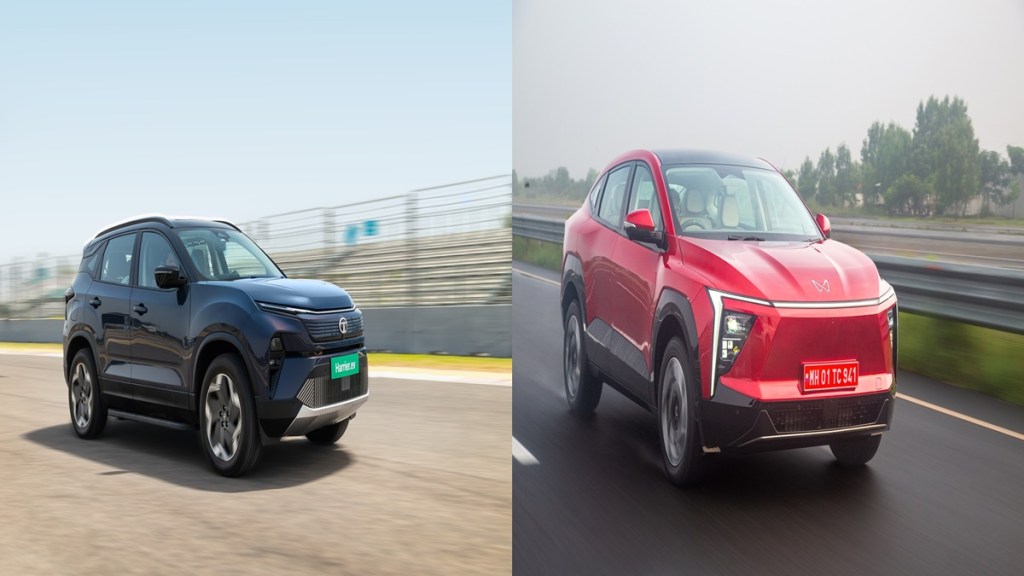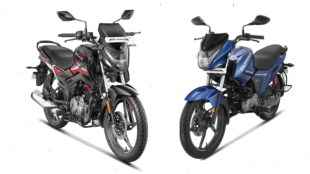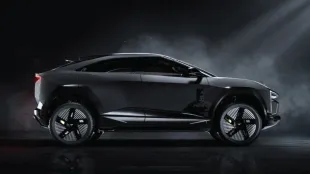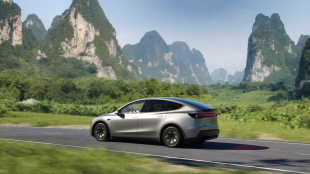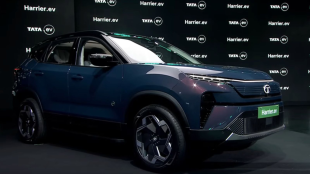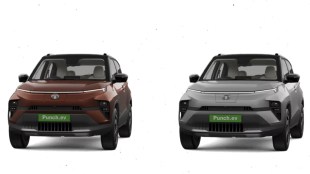With the launch of the Tata Harrier EV, customers looking for a luxury electric car experience – and far below Mercedes-Benz or BMW prices – have one more choice. But between the Harrier EV and the XEV 9e – Mahindra’s flagship electric car – which one should you choose?
We drove both.
Pricing & variants
Harrier EV: It’s available in 65 and 75 kWh battery pack options. The base model (Adventure 65) is priced Rs 21.49 lakh, ex-showroom, and it’s quite loaded, with features such as leatherette upholstery, 18-inch wheels, 8-way driver and 4-way co-driver adjustable seats, 10.25-inch touchscreen with wireless Android Auto and Apple CarPlay, 10.25-inch digital driver’s display, V2V (vehicle-to-vehicle) and V2L (vehicle-to-load) functionality, cruise control, smart key with PEPS, reverse parking sensors with HD camera, automatic climate control, B-pillar integrated rear AC vents, paddle shifters for regen modes, etc.
For Rs 21.99 lakh, you can buy the Adventure S 65 model (with a panoramic sunroof).
For Rs 23.99 lakh, you can buy the Fearless+ 65 model (features in addition to the base model are JBL sound system, ventilated front seats, 360-degree camera, 19-inch wheels, LED front fog lamps with cornering function, and rear fog lamp).
For Rs 24.99 lakh, you can buy the Fearless+ 75 model (same features as the Fearless+ 65, but with a bigger battery).
For Rs 27.49 lakh, you can have the Empowered 75 model (auto park assist, HD screen IRVM with built-in dashcam, digital key, 540-degree surround view camera, Dolby Atmos audio, 14.53-inch Samsung QLED touchscreen, ambient lighting, etc).
For Rs 28.99 lakh, you can buy the Empowered QWD 75 model – it has dual motors, all-wheel drive capability, boost mode, off-road assist, and six terrain modes (Rock crawl, Snow/Grass, Mud-Ruts, Sand, Normal, Custom).
And for about Rs 50,000 extra, you can add AC fast charging, and for another Rs 50,000, you can choose the Stealth model (with cosmetic changes).
XEV 9e: It’s much simpler to choose, with just four variants.
The base model is called Pack One (Rs 21.9 lakh). It has a 59-kWh battery, triple 12.3-inch display (instrument cluster, central infotainment, passenger screen), 19-inch wheels, 4-speaker sound system, fabric seat upholstery, automatic parking assist, cruise control, and more. But in the Mahindra, you have to pay extra for the home charger – Rs 50,000 for the 7.2-kW AC charger, and Rs 75,000 for 11.2 kW.
For Rs 24.9 lakh, you can have the Pack Two (features in addition to the base model are panoramic sunroof, dual-zone climate control, 10-speaker Harman Kardon sound system, leather upholstery, wireless phone charger, digital key, Level 2 ADAS, adaptive cruise control, etc).
For Rs 27.9 lakh, you can buy the Pack Three Select (ventilated front seats, automatic parking, cabin camera, 360-degree camera, keyless entry, air purifier, etc).
The top model is the 79-kWh Pack Three (bigger battery, ambient lighting, more ADAS features).
Both models can also be charged using 15-Ampere 3-pin plug & socket (but it will take 25-30 hours for full charge).
Design & space
The Harrier EV has a similar design as the Harrier ICE, and doesn’t seem to be as much of a head-turner as the XEV 9e. Size-wise, both are similar, but the Mahindra has bigger boot space (663 litres, as compared to Tata’s 502 litres) and bigger frunk (150 litres, as compared to Tata’s 67 litres).
The cabin of the XEV 9e looks far modern – especially because of its huge touchscreen covering almost the entire dashboard – but the Harrier EV seems more functional. For example, Tata’s focus is phygital (there is a big digital screen, but also physical buttons such as for AC), but in the Mahindra even for controlling the AC you’ve to go inside the touchscreen.
Cabin space is almost similar, and both SUVs can comfortably seat five adults, but the driver’s seating position in the Harrier EV is such that the left knee constantly rubs against the dashboard (it’s irritating).
For the rear passenger, both are equally comfortable SUVs.
Drive & feel
We have extensively driven the XEV 9e, and there is very little body roll – because the heavy battery is under the floor, lowering the centre of gravity – no ‘thud’ sound as you drive over potholes or speed breakers, and even when you press brakes hard, it doesn’t ‘dive’ ahead. Its 0-100 km/h acceleration time is 6.8 seconds, and the claimed range is 656 km. My test vehicle showed a real range of about 500 km.
We have driven the Harrier EV only off the road (the QWD model – quad-wheel drive) – and it’s a true-blue SUV. We took sharp turns in the slush, drove over rocks and in the water, and even took it up extreme incline, and at no moment did it lose full traction. It’s got immense power – its two motors produce 504 Nm torque, and if there is any loss of traction, the sheer power just pulls the Harrier EV out of any terrain. The QWD model also has modes such as Rock Crawl, Mud Ruts, Snow/Grass, and Sand, which deliver just the right amount of intervention for the surface you are driving on.
Which is better?
Both have their unique strengths.
You can choose the Harrier EV:
– If you love off-roading or regularly drive in areas with poor roads or no roads;
– If you prefer a more traditional SUV body shape;
– If you want a slightly bigger battery in the base model (65 kWh, compared to the XEV 9e’s 59 kWh).
You can choose the XEV 9e:
– If you want an SUV coupe;
– If you want huge screen on the dashboard;
– If you will never go off the road.
Both most of all, both these SUVs celebrate the arrival of Indian auto-tech finesse, and seem as good as global EVs by Kia, Hyundai, BYD, and entry-level BMWs, all of which cost a lot more.
